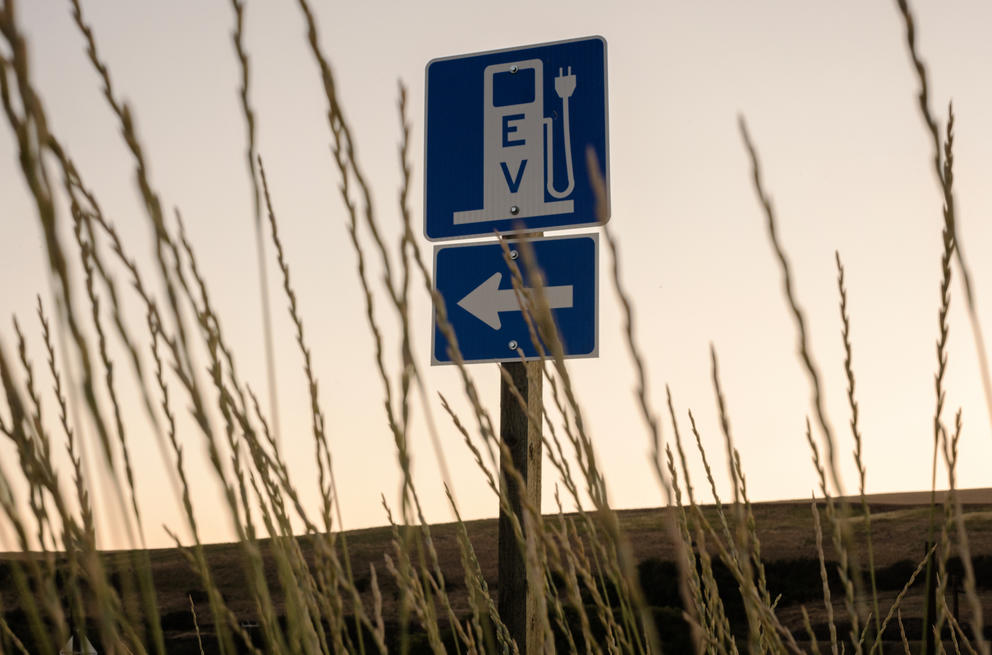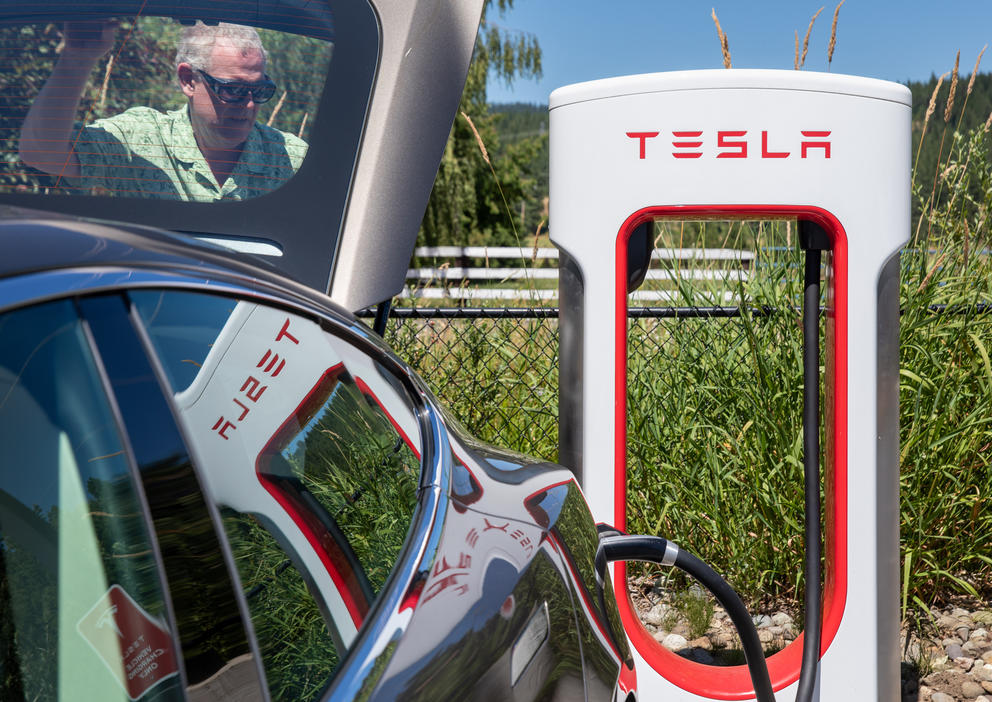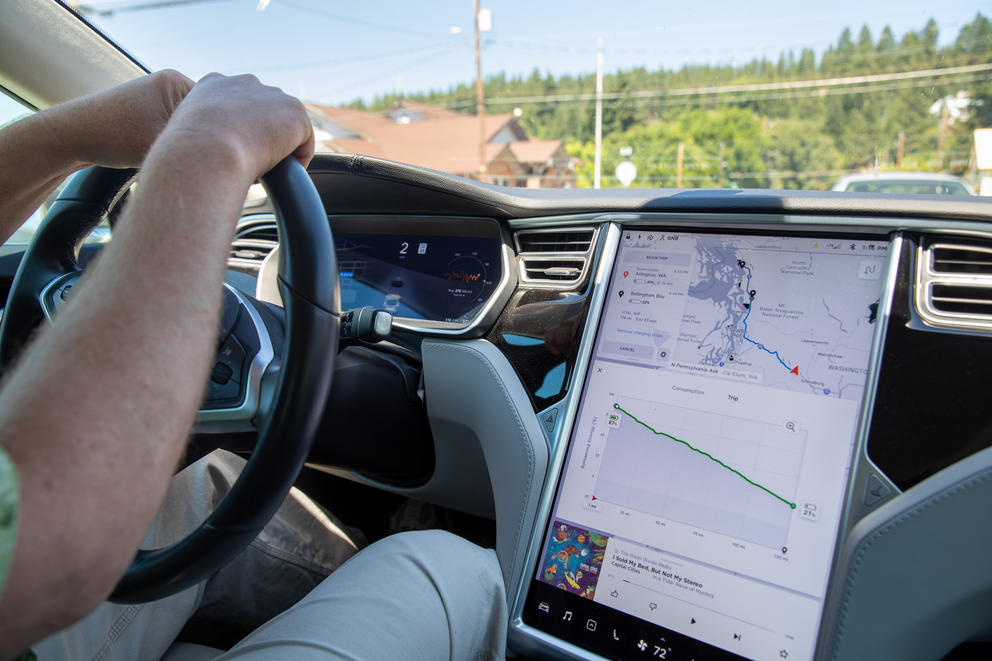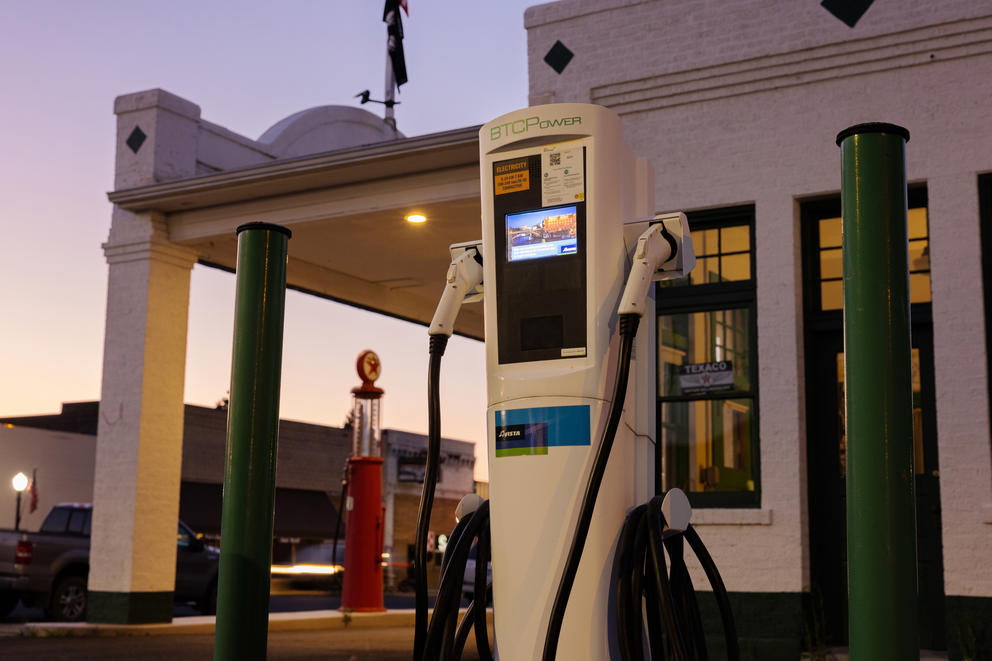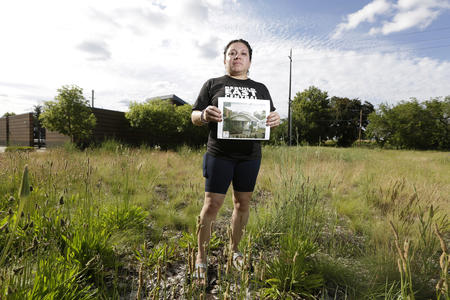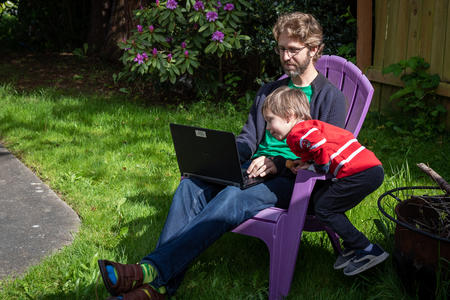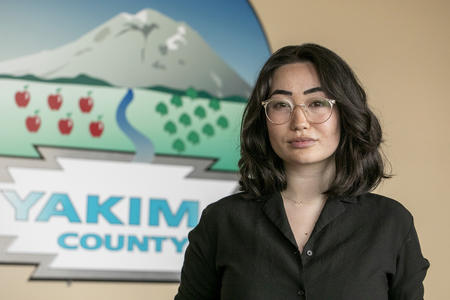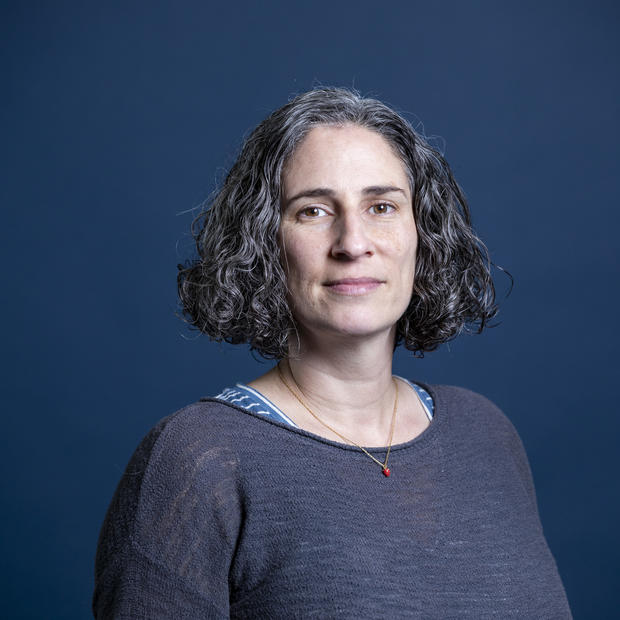They joined the constant rotation of cars pulling through the charging site a couple miles from the small town’s main drag in late July as the state settled into a heat spell. While their 40-minute charge took longer than the average pit stop to fill a gas tank, it gave them time to walk their dog, eat lunch and use the restroom at a nearby cafe. And with a range of more than 200 miles in their Kia Niro’s battery, they needed just one stop to recharge on their journey home.
Not all trips in their electric vehicle go as smoothly for the Olympia family.
“We plan our trips a little differently,” Sullivan said. “On the Olympic Peninsula, there’s not a lot of chargers, so we have to be strategic.”
In just the past few years, the number of electric vehicles registered in the state more than tripled as new EV options became available, according to state licensing data. This year so far, one out of every 10 vehicles sold is an EV. Today about 100,000 EVs roam Washington highways and streets, though they still make up a very small proportion of vehicles on the road.
Gov. Jay Inslee wants to significantly increase that number, ideally ending the sale of new gas-powered cars statewide by 2030. The greater Seattle area, with 70% of EV cars registered to drivers in King, Snohomish or Pierce counties, leads in EV adoption as well as investment from the private market in charging stations to the region.
Outside the Puget Sound area, a classic chicken-versus-egg conundrum still plagues the rural EV market — without ubiquitous charging stations, “range anxiety” over getting stranded far from a charger continues to discourage rural adoption. And without more EVs on the road, building new charging sites isn’t profitable for the private market.
A surge in federal infrastructure dollars could spark the beginning of a national charging network. Washington transportation officials last week submitted a wide-ranging plan to leverage federal money into building out the state’s EV charging grid, but transitioning rural Washington to battery-powered travel still comes with a broad set of challenges.
Less than 2% percent of the state’s existing charger sites meet the latest federal standards while others become obsolete as more efficient chargers emerge. Many locations require costly utility upgrades or high operation costs, which leave private companies wary of investing in charging sites in remote or rarely used areas. Making the shift will take flexible planning, along with more money to install chargers everywhere — not just along interstates and major roads.
If the state can’t get ahead of those concerns, EV advocates warn rural drivers could be left behind.
“As an electric vehicle owner and driver you pre-plan your charging. You arrive at the charging station, you plug it in, you go do what you're going to do. It's 10 seconds,” Garrett Brown said. “And you come back to the car and it's done or you got enough charge to go to your next location.” (Lizz Giordano for Crosscut)
Easing range anxiety
Tri-Cities EV driver Jennifer Harper relieved her range anxiety in 2017 by buying a plug-in hybrid electric vehicle, which contains both a gas and electric engine. Harper’s commute matched the daily range of the electric engine, with a bit left over for errands. She charges it overnight to power it up for the next day. And when she journeys away from the Tri-Cities, the gas engine fills the gaps in the charging infrastructure along the route.
“For me, I just really like the experience of driving on electric. Just how smooth and quiet it is, it reminds me of being on a boat on a crystal clear lake,” said Harper, who sits on the board of the advocacy group Drive Electric Washington. She also works for Energy Northwest, a consortium of public utility districts and municipalities, where she helped lead the effort to build out EV charging infrastructure. She recently transitioned to a different role.
“I drove a plug-in-hybrid,” Harper said. “So I wouldn't say that I was all in. But for the time, with the infrastructure on the eastern side of the state not yet there, it made the most sense.”
In 2020, her lease up, she chose another plug-in-hybrid.
“It's definitely a lifestyle change for anybody that makes the full commitment to driving only electric,” Harper said.
In the Infrastructure Investment and Jobs Act, the massive recovery plan passed to activate the economy in the wake of COVID, there’s $5 billion set aside for states to jumpstart a national network of public EV charging stations. With this money, the federal government aims to relieve some of that range anxiety for new EV drivers by subsidizing the buildout of a fast-charging network — filling in the holes the private market or state investment hasn’t yet plugged.
The National Electric Vehicle Infrastructure program, NEVI for short, will send $71 million to Washington state over the next five years. To receive this money, states had until Aug. 1 to submit a NEVI plan, a blueprint for how the funding will be spent.
This story is a part of Crosscut’s WA Recovery Watch, an investigative project tracking federal dollars in Washington state.
Washington’s newly released NEVI plan focuses on making it possible for the mass adoption of electric vehicles, said Tonia Buell, an alternative fuels program manager for WSDOT and the agency’s lead for the program.
“We're thinking about all potential drivers,” she said, “not just where the current early adopters are, but where people in cities and small rural communities can drive electric.”
Buell said she is all too familiar with the gaps in the EV charging system and the “flatbed of shame” after running out of electrons in her EV near Olympia, stretching the limits of her car’s range. She couldn’t just shift her EV into neutral and get it towed, but rather a flatbed truck was needed to haul the car off to a charger.
Today, a charging station exists at the spot where Buell ran out of electrons.
Garrett Brown’s display in his Tesla maps out the range left in the battery and upcoming EV stations. Many of the existing charging locations in the company's network meet or exceed the federal requirements set out in the NEVI plan, but they are currently only available to Tesla drivers. After waiting more than two decades for an EV, Brown sold his last gas-powered car in 2016. (Lizz Giordano for Crosscut)
Costly grid upgrades
Roger Ovink, another EV driver in the Tri-Cities area, bought his car to use just around town. He eases his range anxiety by never being farther away from home than his current battery range.
In the two years Ovink has owned it, he has only charged the car at home using a trickle charge.
Basically three types of charging exist. Most people charge overnight at home, and a trickle charge, the slowest of all, is usually all they need. It uses a regular outlet, like the one a cell phone plugs into, but can take more than a day, and in some cases more than two days, to charge a fully depleted battery.
Level Two chargers take about four to 10 hours to recharge an average battery. People with long commutes may need one at home, which requires an outlet similar to a washer and dryer.
Fast chargers, the quickest refueling option for EVs, drop refueling time to 15-45 minutes. These are seen as the bare minimum needed for drivers looking to get right back on the road.
NEVI funds can only be used for direct current fast chargers, and federal stipulations also require that four be installed at each location, which may require more power than currently exists at many rural sites.
Jared Knode, an energy and professional services manager with Energy Northwest, can’t think of an installation for an EV station that didn't require a utility upgrade. Usually the nearest transformer, which provides the power to the site, needs to be upgraded.
“This isn't necessarily just true of rural locations, either,” he said. “But it's certainly true in rural locations.”
Ford Motor Co. and Jeep's first forays away from internal combustible engines have helped drive EVs into the mainstream market, especially in rural areas. Within a year of release, each of these models – the F-150 Lightning, the Mustang Mach-E, the electric Wrangler – all ranked in the top 10 models sold in the state.
Charging up an EV Ford 150, which advertisements boast can power a home for up to three days, in less than an hour takes a lot of charging capacity.
“That’s a lot of power to cram through the system in less than an hour,” Knode said.
And for sparsely used charging stations, large spikes created by fast charging could drive up energy prices for regional utilities.
“It runs the risk of driving our rates up for people who don't even use the charger,” Knode said. “You're gonna have utilities, they're just gonna say … the risk is too great.”
To access the federal funding, each charging site at a minimum must be fitted with at least four fast chargers, capable of delivering power at 150kW and filling a vehicle’s battery in about 15-45 minutes. And EV stations must be no more than 50 miles apart from each other, and within a mile of designated alternative fuel corridors. Funds don’t expire, which may come in handy as states reckon with inflation and long wait times for equipment due to supply chain disruptions.
These NEVI requirements could be a challenge for our utilities, said Harper, the Tri-Cities EV driver with Energy Northwest.
Flexibility around the requirements such as number and mix of chargers — both fast and level two-type charging, along with the spacing of stations — could allow more utilities to host charging stations, she added.
The available capacity remains very site dependent, explained Rendall Farley, a manager of electric transportation for Avista Utilities in Eastern Washington, but there are also workarounds for bringing more power to these rural sites.
“In some cases, there’s medium voltage utility power very close, with plenty of electricity,” he said. “And in other cases, there's a bit of work to do to make that happen or battery storage might be needed to support the fast chargers.”
Some stations could be set up to slowly pre-charge on-site batteries and then drivers could fast-charge off those batteries to get back on the road faster, he added. NEVI funds can be used to update electrical infrastructure.
The NEVI money is a key piece of establishing a national network of fast charging along interstates, Farley said, so that people can confidently take their EV on a longer trip without inconvenience.
Completing the EV charging network
Garrett Brown waited 20 years for the electric car he purchased in 2011, so range anxiety was never something he needed to conquer. His first road trip from the Tri-Cities to Anacortes in 2012 required careful calculations to plot out the mileage between charging stations. Even with meticulous planning, his Nissan Leaf needed a recharge every 60 to 80 miles. For that first leg of the trip to Kirkland, Brown and his wife left well before dawn and arrived long after dark.
“I'll just say that that was beyond the limits of the infrastructure at the time,” said Brown, who founded the Mid-Columbia Electric Vehicle Association.
At one point, a sympathetic barista let them plug in for a few hours at a coffee shop after an unexpected headwind left Garrett questioning if the car had enough juice to make it to their first planned stop.
“We obtained the grace of several people in several locations to help us,” Brown recalled.
Switching to a Tesla a few years later allowed Brown to tap into the company's proprietary charging station system that far outpaces today’s public system in its reach. There’s talk of Tesla opening up its charging stations to other EVs, as state and federal government money flows into the industry, but for now it's a big selling point for the company.
The same trip from the Tri-Cities to Seattle’s Eastside now nearly rivals the time it takes in a gas-powered car, requiring just one recharge, he said. New destinations still require some forethought while a few other places, like Mount Rainier, still remain out of range.
Washington leads in EV adoption, along with California and Oregon. These three states banded together to create the West Coast Electric Highway. But large gaps still exist in the charging network, especially outside urban areas. Some of the charging infrastructure is fast becoming obsolete – as ever speedy charging options emerge and larger batteries become available – and many don’t meet the requirements set out in the NEVI plan.
Find tools and resources in Crosscut’s Follow the Funds guide to track down federal recovery spending in your community.
About 1,650 public electric vehicle chargers can be found statewide, but fewer than 200 locations offer DC fast chargers. Transportation officials say only 27 of those sites meet NEVI program standards. Some sites don’t have enough charging stalls or enough power capacity to be a fast charger, especially the older sites. Many Tesla sites meet, or even exceed, the NEVI requirements, but aren’t publicly available.
NEVI funding stipulates that states start outfitting highways designated as alternative fuel corridors, making sure there’s coverage at least every 50 miles, before tackling other roads. Washington’s NEVI plan prioritizes charging coverage along I-5 and I-90, followed by I-82/I-182, U.S. 395 (south of Spokane), U.S. 101 and U.S. 195.
“A very important part of the NEVI program is really to build charging stations just ahead of the demand for the charging stations to then really spur on and trigger accelerated adoption of electric vehicles,” said Molly Middaugh, director of business development at EVgo. The company builds and operates charging stations while also consulting on how to build out EV infrastructure.
“I think having these stations every 50 miles on all the designated major highways and corridors will be a huge step in helping to accelerate transportation electrification,” she said.
When deciding where to build EVgo sites, Middaugh said the company takes into account the number of EVs registered, nearby amenities, traffic patterns and types of housing in that area.
Still, even with the new federal money to build stations, Middaugh said EVgo has no plans to bid out projects on its own and own stations built with NEVI funding. Instead, the company plans to partner with companies like Pilot Flying J, the ubiquitous truck stop chain, on proposals for the money.
Buell, with the state Department of Transportation, said officials hope to encourage investments in all sizes of communities by bidding out NEVI-funded projects along entire highway corridors or segments, not just individual sites. She noted that approach, which WSDOT used to distribute state EV funding, still hinges on additional guidance from the federal government.
“That’s likely the strategy we’ll use for contracting, particularly to avoid vendors cherry picking the best spots and skipping the rural areas where usage is anticipated to be lower,” Buell said. “So they're gonna get some high-usage locations, then they'll have to put some stations in that aren't going to get as much usage.”
In the end, WSDOT does not want to own these stations, but rather create public-private partnerships to build these stations, and leave operations and maintenance up to private companies or utilities. Some rural sites might also require ongoing subsidies for maintenance and operations to meet reliability standards, which can be done with NEVI funds for up to five years.
As proposals come in, WSDOT will consider different amounts of ongoing support between urban and rural sites depending on anticipated usage, Buell said.
Part of the NEVI funding also requires that 40% of the overall benefits from the program go to disadvantaged communities. To do that the state is also developing a publicly available mapping and forecasting tool that shows existing EV drivers, daily traffic counts, employment, existing chargers along with health and environmental disparities data and racial demographics to help guide the state in choosing new sites.
Rural gaps remain
Jon Jantz, an energy consultant who works mostly with nonprofits and rural electrical utilities on electrification, said NEVI is a great foundational first step to building out a charging network, but it’s going to take a lot more funding and investment to really fill in gaps across rural Washington.
The competitive grant process could leave many small towns behind, he said, noting the groups and areas who need the NEVI funding most often have the fewest resources.
“They don't have a grant writer. They don't have somebody who's up to speed on all the nuances of this and how to do it,” he said. “Most are never even going to hear about the program.”
Some sites might need larger power capacity and/or more charging stalls than required in the NEVI plan to meet future demand, Jantz said. That’s where flexibility in the plan is important, which the state is allowing for, he added.
Rural areas also stand to benefit from widespread EV adoption. Charger access can draw new visitors to small communities (and result in them spending more money as they wait to recharge). Many rural drivers tend to have longer commutes and often spend more of their income on transportation than their urban counterparts.
While it’s more expensive to purchase an EV – though advances in battery technology are quickly dropping prices – owners of these cars spend about half as much on repairs and maintenance compared to a similar gas-powered car, according to an analysis done by Consumer Reports. Shifting from gas to buying electrons can drop fuel bills by 40%.
While moving to EVS will not reduce traffic congestion or eliminate greenhouse gas emissions from the transportation sector, it is one of only two plausible pathways to a deep decarbonization of road transportation, said Don MacKenzie, associate professor at the University of Washington and director of the university’s Sustainable Transportation Lab. The other is hydrogen.
“Notwithstanding the one issue of range and recharging time, in terms of how they drive, how they accelerate, how much they carry, their comfort,” MacKenzie said, “[EVs] meet or I would even say greatly surpass conventional vehicles and their capabilities. So it's a really exciting time from a product standpoint.”
“The one way we could screw this up,” he said, “is if the infrastructure isn't there.”

